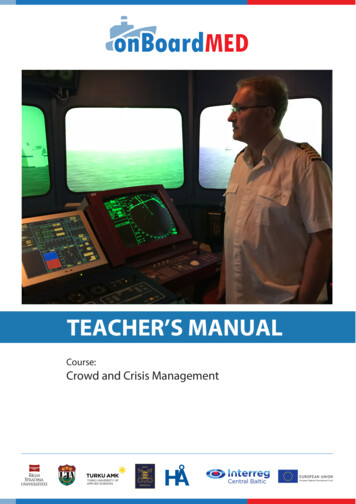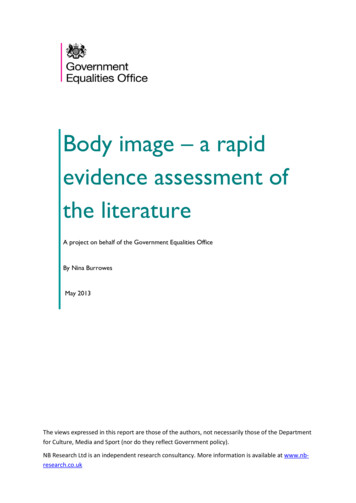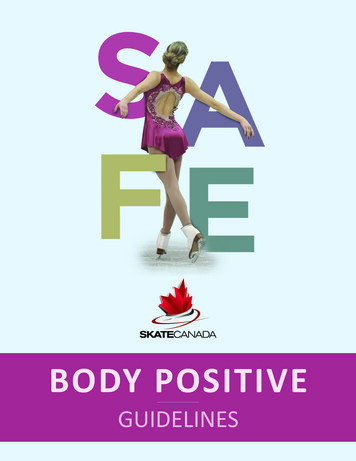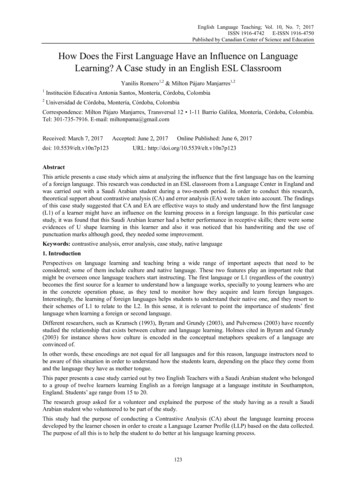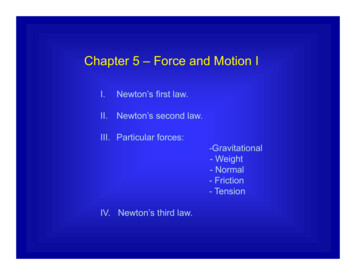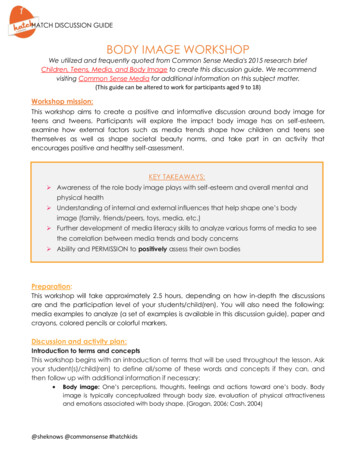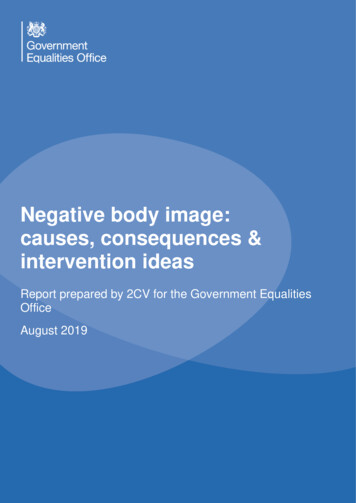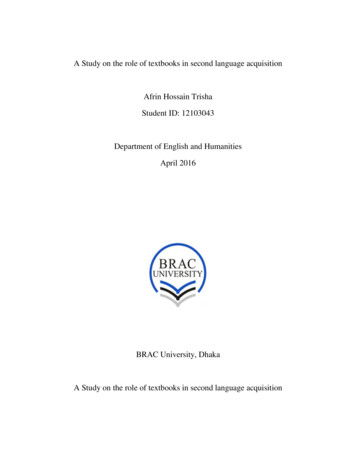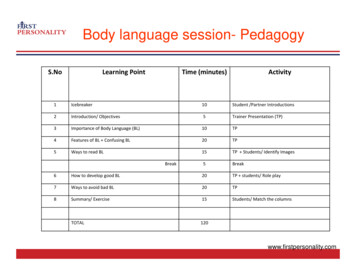
Transcription
Body language sessionsession- PedagogyS.NoLearning PointTime (minutes)Activity1Icebreaker10Student /Partner Introductions2Introduction/ Objectives5Trainer Presentation (TP)3Importance of Body Language (BL)10TP4Features of BL Confusing BL20TP5Ways to read BL15TP Students/ Identify Images5BreakBreak6How to develop good BL20TP students/ Role play7Waysy to avoid bad BL20TP8Summary/ Exercise15Students/ Match the columnsTOTAL120www.firstpersonality.com
Body Language“ He who does not understand alook will not understand a longgexplanation either ”Ancientproverbwww.firstpersonality.com
Understanding Body Language“ HeH whoh ddoes nott understandd t d a llookk willillnot understand a long explanation either ”Ancient proverbwww.firstpersonality.com
What is Body Language ?9Body language is the language transmitted bypost re clothes,posture,clothes gesturesgest res and facial expressionse pressions9 It is the unspoken communication that goes on inevery Face-to-Face encounter with anotherhuman being9It tells you their true feelings towards you andh wellhowll your wordsd are beingb i receivedi dwww.firstpersonality.com
Factors that affect Body LanguagePosture & Clothes Gestures Facial expressions: 23%: 57%: 20%www.firstpersonality.com
Importance of Body Language9Our physical gestures are subconsciously interpreted by others9 Provides information about an individual’s character, emotions,aandd reactionseact o s9 Body language presents to audience what we feel & think aboutthe particular matterwww.firstpersonality.com
Features of Body LanguageNervousnessClearing throat,throat "whew"whew sound,soundwhistling, smoking, pinching fleshcovering mouth, jiggling money orkeys, tugging ears, wringing handsShort breaths, "tsk" sound,tightly clenched hands,wringingi i hands,h d fistfi t likelikgesturespointing index fingerrubbing hand through hair.Frustrationwww.firstpersonality.com
Features of Body LanguageOpenp hands, unbuttoned coatOpennessArms crossed,Ad sidewaysidglance, touching-rubbingnose, rubbing eyes, buttonedcoat,, drawingg awayyDefensivenessInsecurityyPinching flesh, chewingppen, thumb over thumb,biting fingernailswww.firstpersonality.com
Features of Body LanguageUpper body in sprintersprinter'ss positionposition,Cooperation open hands, sitting on edge ofchair, hand to face gestures,unbuttoning coat.Steepled hands, handsbehind back, backstiffened, hands in coatpockets with thumbout, handsa ds ono lapelsape s oofcoatConfidencewww.firstpersonality.com
Features of Body Language Tapping foot or holding something in hand andfiddling withith it or havingha ing a keyke chain in finger andmoving it around finger. All this indicatesrestlessness disinterest and a desire to end therestlessness,session.Moving key-chain around one's finger is an indication of a desire to leave.www.firstpersonality.com
Remember .Anyone who gives you a handshake with two hands,when first meeting youyou, is likely to be insincere andoverwhelming, or even deceitful.9Tip: Exception is elderly peoplewww.firstpersonality.com
Confusing Body LanguageShe may feel comfortable,Sh may llookk cool.ShelCareful, you have a very negative signal,even if she is smiling.www.firstpersonality.com
Confusing Body LanguageThe lowered steepling of the hands indicates listening,and can also be a negative confidence gesture.www.firstpersonality.com
Confusing Body LanguageThe scratch to the back of the neck indicates uncertainty.www.firstpersonality.com
Confusing Body LanguageIt can mean nervousness or deceit.It can mean a desire to shut out the words they are hearing,hearingor the words aren't 'going in'.they've heard enough.www.firstpersonality.com
Confusing Body LanguageHot under the collar!People touch their face 10 times more than normalwhen they feel uncomfortable. When you lie, youfeel a tingling sensation around your face and neck,and feel you need to touch or relieve the area.www.firstpersonality.com
Class ExerciseCan you identify the bodylanguage from each of thefollowing images displayed?www.firstpersonality.com
2. Attentive4. Anxious3 Angry3.1. Affectionate5. AshamedConfidentConfused6. Bored
ied
Ways to develop Positive Body Language Be Energetic! Display variety in your gestures Display Purpose No pacing,pacing rockingrocking, swaying Exercise and stay fit No body odour Respect personal spacewww.firstpersonality.com
Proper Posture9 Erect posture- eager to do task(Could also be hostile)9A pperson with a straightg head,,erect shoulders, fast steps andstraight posture gives an impressionof a confident person9 Stooping shoulders gives animpression of an under-confident personwww.firstpersonality.com
Eyes (as you see them)Eyes - upward to the right (their left)Trying to recall memoriesEyes - upwards to the left (their right)Creating visual images (we think in pictures)www.firstpersonality.com
What your eyes say about you?“ Face is the index of the mind ", and the eyes are 50% of it! GazingG i towardsd blblankk whilehil conversingi isi an indicationi di iof recollecting something . Shutting eyes frequently indicates disinterest or lackof keenness in the discussion and the subject matter.It is a sort of escapist reaction. Best is to practice looking above the eyes, near the forehead(above the nose) of the other person while speaking .9 TIP: Make eye contact for 3-4 seconds but don’t stare. Look longenoughh to identifyid if theh otherh person’’ s eye colourlwww.firstpersonality.com
Correct Handshake Handshake is an integral part of one's personalityCCorrecthhandshaked h k can greatlyl improveifirstfi impressioniiPractice a strong, well gripped and vertical handshakeA well gripped and strong handshake creates apositive impression NoN wet hhands,d no lilimp handsh d Shake from the elbow, not shoulder Shake hands with women alsowww.firstpersonality.com
Ways to develop positive body languageSteepling HandsThis is frequently used in superior/subordinate interaction.It demonstrates confidence and a 'know-it-all' attitude.There are 2 versions:1) The raised steeple - when the person is talking, expressing theiropinion2) The lowered steeple - when the person is listeningwww.firstpersonality.com
Ways to develop positive body languagePalm GrippingThis is a confidence/superiority position. The person hastheir stomach, heart and throat regions exposed which isan unconscious act of fearlessness.9 TIP: If you are in stressful situation assuming thisposition can help calm you down and take control of thesituation.www.firstpersonality.com
Ways to develop Positive Body LanguageMirroring Positions Two people talking, standing in the same poseThis indicates that they are in agreement with each other, theylike each otherIf you want to establish a rapport with someone, mirror theirposesThis will have the effect of relaxing themGive them a non-verbal indication that you are both thinkingalong the same lineswww.firstpersonality.com
Negative Body Language to avoid Feet dragging - implies lethargy - unlikely to impressHead down - implies timidity, again not a positive impressionShoulders drooped - implies lethargy and wearinessWeak handshake - implies meek and ineffectual personalityShift eyesShiftye es - implies nervousnessner o snessArms crossed on chest - implies a defensive stanceFidgetinggg - impliespnervousnessHands in pockets - implies you have something to hide9 TIPTIP: RRespect personall space don’td ’ standd too closelini meetingior elevatorswww.firstpersonality.com
Poor HandshakeWEAK HANDSHAKE-THE FISH WET FISH’ from a man this normally means a weak character,someone who is easily persuaded.www.firstpersonality.com
How to identify Liars? Covering the mouth with the hand Scratching the nose quite frequently Moving the hand to scratch or rub the ear Scratching the side of the neck with fingers
ConclusionWith the right information and a little practice,we can traini ourselveslto overcome most off ournegative body language habits.www.firstpersonality.com
What is Body Language ? 9Body language is the language transmitted by post reposture, clothes, gest resgestures and facialand facial e pressionsexpressions 9It is the unspoken communication that goes on inspoken communication that goes on in every Face-to-Face encounter with another huma
